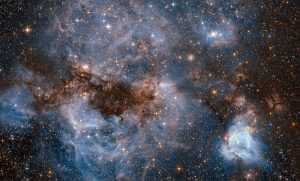The Period of Luminosity Law
Miss Henrietta Swan Leavitt (1868 – 1921) of Harvard College Observatory studied the Cepheid variables in the two Magellanic Clouds. By 1912 she had come up with a remarkable discovery that would secure her place in the annals of astronomical observation. She found there was a relationship between the apparent magnitudes of the Cepheids in the Magellanic Clouds and their periods of variation: the longer the period the brighter was the star and the smaller was its magnitude number. She pointed out that because the Small Magellanic Cloud was so far away its members, to all intents and purposes, could be taken to be the same distance from Earth. In other words there was no appreciable difference between the distances of stars on the far side compared with the near side of the Small Magellanic Cloud.

Essentially she determined that the period (the length of time between minimum and maximum brightness) of a Cepheid variable star was proportional to its apparent magnitude. Unfortunately, in her time, Leavitt did not have an accurate distance of the Magellanic Clouds so the absolute magnitudes could not be calculated. It was to be some years before astronomers had a better idea of the actual distances.
In the 1920s a scale of absolute magnitude corresponding to the scale of the apparent magnitudes was decided upon. From this it was found that the Magellanic Clouds were more than 100 000 light years away.
Further research and refinements improved the astronomers’ techniques of measurement. Walter Baade (1893 – 1960) studied the Andromeda Galaxy, previously determined to be at least 900 000 light years distant, according to Edwin Hubble (1889 – 1953). Baade felt that the Cepheid scale needed revising. He distinguished two classes of stars in the Andromeda Galaxy: bright blue stars he called “Population I” stars whose spectra were rich in metallic lines; and “Population II” stars whose spectra were poor in metallic lines. These two types differed in their luminosities and periods. Population I Cepheids were 1.5 magnitudes brighter than Population II types. In this way he found the scale of absolute magnitudes, as applied to the Cepheids prior to 1952, was in error by a factor of 2. The more accurate value for the distance to the galaxy, he determined, was 2.2 million light years. Modern data fine-tuned this to about 2.5 million light years (authorities range from 2.48 to 2.54).
As for Miss Leavitt’s Magellanic Clouds, the most recent calculations give the distance to the Large Magellanic Cloud as 166 000 light years, and to the Small Magellanic Cloud 200 000 light years. It means that modern astronomers, using Leavitt’s valuable data, can now accurately determine distances to pretty well any object in the sky using an updated table of her Cepheid variables.
Relationship of mass and luminosity
In 1924 Arthur Stanley Eddington (1882 – 1944) realised a high corelation between mass and luminosity of main sequence stars. Only supergiants and white dwarfs did not fit this relationship – as of course they are not members of the main sequence fraternity. He noted that the luminosity is proportional to 3.5th power of the mass. Sub-giants and ordinary giants also fit into this relationship. Since then a great many astrophysicists have continued the study of this relationship. The upshot is that they found there was a very high coefficient of correlation of 0.98 in the relationship and this forms the basis of the mass-luminosity law, and it states:
the logarithms of the luminosities of stars are proportional to the logarithms of their masses.
So if you know the luminosity of a star you can usually work out its mass.
Back to Top
By Nigel Benetton, science fiction author of Red Moon Burning and The Wild Sands of Rotar.
Last updated: Wednesday, 3rd March 2021